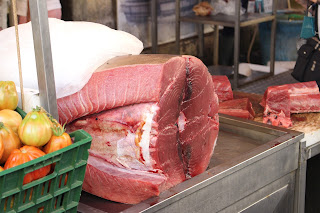On Saturday, June 17th, we started with a walking tour of Ortygia. We went through the lively market to the Temple of Apollo, then through the narrow streets to the Piazza del Duomo. Visiting the cathedral felt odd—it is both an ancient Greek temple, to Athena, and a baroque cathedral. The spaces between the columns were simply walled in, the entrance of the building was shifted from east to west, and Ecco, you have a church! After an earthquake, a new, baroque façade was added.
Then we visited the Church of Santa Lucia alla Badia. The virgin and martyr St. Lucy, well known to Swedes and Neapolitan singers, was a Syracusan and met her end there. Again, as at San Lorenzo in Palermo, we meet Michelangelo Merisi da Caravaggio here (not for the last time). His painting “The Burial of St. Lucy” is on display in the church. On this trip, we came to appreciate Caravaggio’s genius more than we had before. He had been required to revise this painting: originally it had shown the saint’s head separated from her body, but this was too much for his patrons, so he filled in the gap and instead showed a small wound on her neck, with a little trickle of blood.
This was the day we saw a Sicilian puppet show. It used large, elaborate marionettes to tell the story of “Rinaldo and the Dragon’s Cave,” in which Rinaldo, one of Charlemagne’s paladins, fights a dragon, a bunch of Saracens and a witch, in order to rescue people whom the witch had been feeding to the dragon. Along the way, the Saracen princess Angelica, who is hopelessly in love with Rinaldo, tries to rescue him, with the help of an evil sorcerer and a demon, but Rinaldo refuses to be rescued, and meanwhile, Angelica’s comic-relief nurse thwarts the sorcerer’s plot to kidnap Angelica for himself. Virginia got all the tour members refrigerator magnets in the shape of the heads of the puppets (we got Angelica). In the end, dragon, witch, sorcerer and Saracen soldiers are all defunct, and the rescued people cheer our hero. All this was in Italian (not Sicilian—a separate language and not a dialect of Italian--as we had been told), but the notes we had received enabled us to follow along pretty easily.
Mary Joy and I had lunch (with the same couple we had eaten with in Trapani) at a restaurant called Clandestino—again, very good. Then, we went to the Church of San Filippo, on the site of a medieval synagogue, and were guided down the stairs to a mikveh, or Jewish ceremonial bath.
That evening we tried a restaurant that was recommended by Giorgio and our hotel—la Tavernetta da Piero. I forget what we had—other than the sea urchin bruschetta (definitely an acquired taste!)—but we had been spoiled by the meals we’d had so far on this trip, and while it wasn’t bad, we weren’t impressed.






























No comments:
Post a Comment